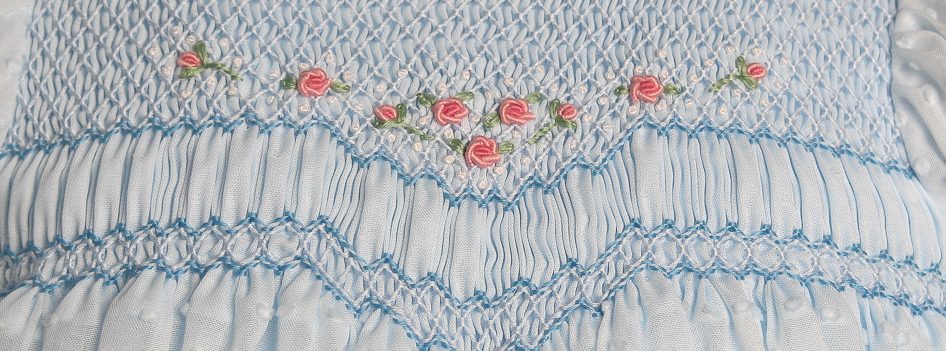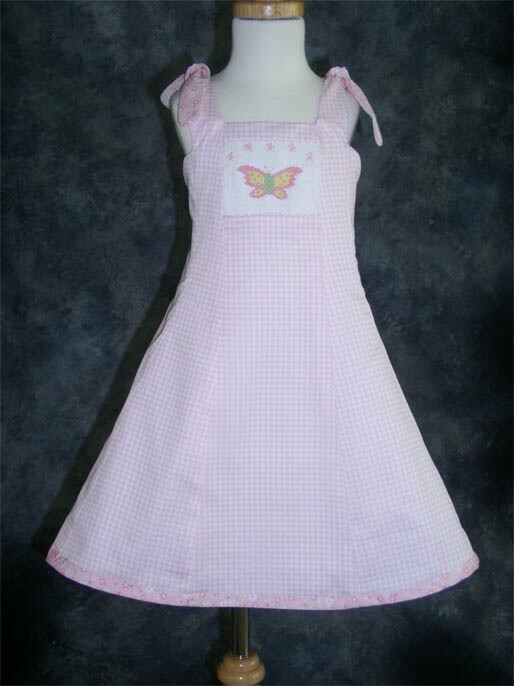A beautiful hemline is a lovely way to compliment a bodice – smocked, embroidered, tucked, etc. There are so many ways to embellish a hem. Some are more time consuming and difficult, others are quicker and easier (relatively speaking). This post will address some of the many options of interest to anyone that enjoys heirloom sewing. Hopefully it will inspire some creative thinking for your next sewing project!

A smocked bishop dress is deserving of a beautiful hem treatment. This hem was stitched with a pin-stitch, done by hand and then embroidery was added above the hem. While I nearly always will choose a machine method of hem finishes, I do love hand-work and wanted to test the waters with a hand, pin-stitch. With a small sized bishop dress, this didn’t take too long. This is a cost effective treatment and only requires a lightweight thread for the pin-stitch. Any book on heirloom techniques will include instructions for this stitch.
For reference, this dress was made from Imperial batiste. The smocking design is a variation of Ellen McCarn’s “Cary Anne” smocking plate – I made a few changes. Contrary to the opinion of many heirloom stitchers, it IS possible to do a hand pin-stitch on a poly/cotton fabric. Because of the easy care of this fabric, this dress is likely to get more wear than one that requires special laundering as well as ironing.

As mentioned, my “go-to” methods are almost always a machine method and I love including color in the hem and bodice of a dress.

Scalloped hems always look beautiful!!! Of course, they are more work and will take more time. The finished result is always worth the extra effort! This dress has a scalloped, contrast hem that is machine pin-stitched. Machine pin-stitching also takes time, but goes much more quickly than doing it by hand. Pintucks and embroidery above the hem elevate the design, making it even more beautiful. Pintucks are an easy way to embellish a hem and no additional cost is incurred!

This pattern is available in my Etsy shop.. The fabric for this dress is satin batiste – both the white and the yellow fabric. It is dreamy to work with and creates a keepsake heirloom.

This dress is similar to the yellow/white dress above, but a little quicker to complete. This is a Madeira hem in a contrast color that is machine pin-stitched to the skirt. It has hand embroidered shadow work above the hem – both of these elements are repeated in the bodice.
This dress is made from Imperial batiste for the easy-care that the fabric offers. Because of that, it was worn often, washed frequently and still looks beautiful. As you can see, the machine pin-stitching can also be done effectively on a poly/cotton blend. The pattern and instructions for this dress is available in my Etsy shop.

This is another example of a contrast hem – a shadow Madeira hem, done by machine. The technique for this hem is a bit different. A heavy contrast fabric (hot pink) is used underneath the batiste skirt to shadow through as a pastel pink. This method is much quicker and easier than the previous 2 dresses shown and only requires a pintuck needle and foot and a wing needle. The dress features hand embroidery above the hem. The contrast fabric and embroidery are repeated on the dress bodice.

For an heirloom look with less hours invested, this style will fit the bill. This dress is also made from Imperial batiste, so another easy care dress that should get worn frequently. The pattern is available in my Etsy shop.
Shown below is the same hem technique done with a simple scallop design and with silk ribbon embroidery at the peaks. It is such a versatile technique!


This is yet another dress using the same technique.


Swiss batiste blue dress with lace.

Satin batiste lace dress with lace overlay bodice, sleeves and a lace scalloped hem.

Pima cotton lawn dress with lace bodice and hem.
It goes without saying that you can never go wrong with a traditional heirloom dress and LOTS of lace! Each of these examples show how the lace hem is a repeat of the lace bodice.
The blue dress is a basic yoke dress using heirloom techniques to add lace. The white dress is a basic yoke dress, smocked, and with heirloom techniques to add a lace overlay bodice, lace sleeves and a scalloped lace hem. This dress was featured in Sew Beautiful magazine several years ago. The pink dress is a pattern available in my Etsy shop.

Sometimes a single lace edging is sufficient as a hem. This adds a touch of elegance without taking away from the dress bodice embroidery and the lace sleeves. This vintage inspired dress pattern is available in my Etsy shop.


To create an heirloom dress with lots of appeal and a little less expense, ribbon can be used in the hem and bodice paired with lace for a stunning dress. This is a great way to learn and use heirloom techniques without breaking the bank! These dresses are made of Swiss batiste, ribbon and lace. It does not require a lot of fabric and could also be made with Imperial batiste if easy care and savings is a factor.
With Easter fast approaching, consider a beautiful hem to compliment whatever you might be creating for someone special!!! You can’t go wrong!
Happy Stitching,
Kathy


















